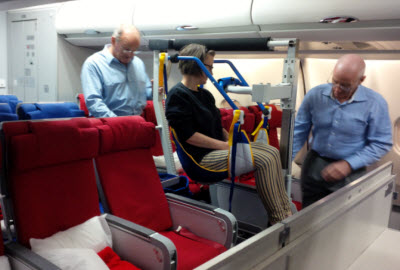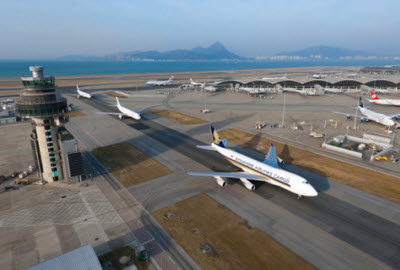Hoists replacing manual handling to get disabled people on planes
- Written by Roberto Castiglioni
 Manual handling to get on and off planes can be an unpleasant experience as veteran frequent flyer Martyn Sibley explains.
Manual handling to get on and off planes can be an unpleasant experience as veteran frequent flyer Martyn Sibley explains.
"I love flying, and the thrill of seeing new places, but the process is a means to an end, not a pleasure," Martyn, who suffers from Spinal Muscular Atrophy, said. "At the gate I use a transit seat to be lifted by two people, and to not be manhandled as much. The worst situations on landing are communicating my needs in a foreign language, which makes me feel scared of being dropped.”
Last year, retired Chief Superintendent of police Anthony Jones wrote a letter to Lord Cotter voicing his disappointment with manual handling.
“I have MS and I am confined to a wheelchair,” Anthony says in his letter to the Peer. ”I am 70 years of age and a retired Chief Superintendent of police. I am a frequent flyer, and expect to be treated with respect when travelling, but find that the procedure used to handle people with reduced mobility is antiquated and demeaning.”
His letter follows an incident he had on the 15th of November returning to Bristol from a short holiday in Spain. "Who the hell put you in that bloody seat, two of our drivers are off with bad backs and I will join them tomorrow after this," one of the helpers told Anthony.
“They both struggled to lift me from the aircraft seat and to place me into the aisle chair, my upper clothing was pulled up above my chest and the whole experience was uncomfortable and traumatic,” he said.
Manual handling is dangerous for passengers and helpers alike. Back injuries are the single most common work-based injuries recorded in the UK and around the world, and they are almost always avoidable.
Every party loses with manual handling, including employers. Almost 31 million days of work were lost last year due to back and muscle problems, according to the Office for National Statistics.
One Australian company has been spearheading the introduction of medical grade hoists in aviation. Haycomp Pty Ltd patented the  Eagle Hoist concept. The specially adapted medical grade hoist is designed to fit planes’ narrow aisles and is available at growing number of airports across the world. “We have sold approximately 80 units over the last 12 months mainly into Canada, USA, Australia, and Dubai,” Haycomp CEO John McGuinness tells Reduced Mobility Rights.
Eagle Hoist concept. The specially adapted medical grade hoist is designed to fit planes’ narrow aisles and is available at growing number of airports across the world. “We have sold approximately 80 units over the last 12 months mainly into Canada, USA, Australia, and Dubai,” Haycomp CEO John McGuinness tells Reduced Mobility Rights.
Last year, Haycomp held test trials of the Eagle 2 hoist at Virgin Atlantic Airways headquarters in Crawley. Follow this link to read more about the Eagle 2 test trial.
Laura Moore attended one of the trials and soon after launched an online petition asking Gatwick airport to buy the Eagle.
“Imagine a world where you are stuck in a chair and cannot move without the assistance of a hoist,” Laura said. “At present airports provide staff to help lift the passenger. Would you really want airport staff, strangers you have never met to man handle you and carry you to your seat? How undignified is that? You would be embarrassed, humiliated, uncomfortable and at risk of injury. It would set the tone for the rest of your flight as being an awkward and non-enjoyable experience.”
Within days, Gatwick airport announced plans to purchase one medical grade hoist for trials. The hoist is now in service at Gatwick. Reduced Mobility Rights understands live tests returned positive feedback from passengers, helpers, and airlines.
Boarding via hoist are not only safer, but also faster. We understand the average time for taking a passenger from the ambulift to the seat is around two minutes.
 The good news from Gatwick quickly made their way north. Lauren Senior is a full-time carer for her brother Jacob who has muscular dystrophy.
The good news from Gatwick quickly made their way north. Lauren Senior is a full-time carer for her brother Jacob who has muscular dystrophy.
“When my younger brother has to travel by plane he, like many other disabled people, has to be dragged onto a dreaded aisle chair, transferred and dragged again into his seat,” Lauren said. “This kind of manhandling by strangers is humiliating, uncomfortable, and unsafe. He usually gets injured somehow during the whole exhausting process.”
Following Laura Moore’s footsteps, Lauren also launched a petition to ask Manchester Airport to purchase medical grade hoists.
“We continually look to improve the services offered to all our passengers and are currently working with our Special Assistance partner to review the equipment used for transferring disabled passengers onto aircraft,” a spokesperson for Manchester Airport said.
On Tuesday, Haycomp management visited Manchester airport for a demonstration of the Eagle hoist. “Manchester asked for a trial  as soon as possible,” John McGuinness said.
as soon as possible,” John McGuinness said.
The purchase of medical grade hoists is cost neutral at airports across Europe. The cost of the hoist can be allocated towards existing airports charges (PRM charges) on departing passengers that cover the cost of services for passengers with disabilities. Click here to learn more about the cost of assistance for the disabled at European airports.
In the UK, Newcastle and Birmingham airports are also hosting demonstrations of the Eagle hoist. But while Britain is warming up towards replacing man handling with hoisting, the rest of Europe is still lagging behind. Medical grade hoists can only be found in use at Krakow, Tirana, and Oslo airports.
Perhaps legislation can help promote change. On 16 July 2013, the Norwegian Ministry of Transport adopted a new Regulation on universal design of airports and disabled people rights in air transport.
In a bold move, Norway banned man handling of disabled people at airports. The new rules state that manual handling should never be used unless the airplane type does not allow the use of hoists. The rule says that hoists should be used to “ensure a safe and memorable experience for the passenger.”
While Europeans are looking at medical grade hoists, Asian airports remain indifferent. “My condition is deteriorating, you know I don't know how long I'm going to be here for and I'm trying the very best to fulfil a few of my bucket list dreams and this was one of them, going on the Queen Elizabeth,” Australian Kim Jago said in an interview with ABC News. “Unfortunately the Queen Elizabeth doesn't return and I have no choice but to fly home [from Hong Kong].”
indifferent. “My condition is deteriorating, you know I don't know how long I'm going to be here for and I'm trying the very best to fulfil a few of my bucket list dreams and this was one of them, going on the Queen Elizabeth,” Australian Kim Jago said in an interview with ABC News. “Unfortunately the Queen Elizabeth doesn't return and I have no choice but to fly home [from Hong Kong].”
Kim contacted Qantas after booking a flight from Hong Kong to Melbourne but was told hoists are not available at Hong Kong airport.
“The Airport Authority Hong Kong (AA) has been providing facilities and services to assist persons with reduced mobility (PRM) at the Hong Kong International Airport (HKIA),” a spokesperson for the Chinese airport told Reduced Mobility Rights. “PRM can travel barrier-free to and from the frontal gates and within passenger terminals of the HKIA. For access to and from remote parking spaces of the airport, the AA provides wheelchair lifting service with high lift platform truck to facilitate PRM with their companions or service agents on board the aircraft or deplane via the aircraft door designated by the airlines.”
We understand Airport Authority Hong Kong is currently reviewing Mrs Jago’s case and the possibility of providing medical grade hoists to facilitate boarding passengers with disabilities.










